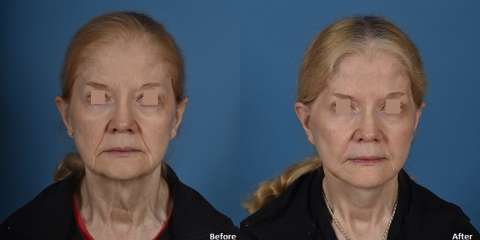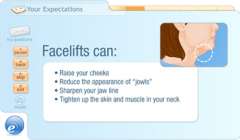Facelift
Find your care
Our team is made up of experts and leaders in the art and science of plastic surgery. To learn more about our services, call 310-825-5510.



As we age, our face loses some of its youthful contours. Gravity, heredity, sun damage, weight flucutations, and stress all play a role. A facelift (or rhytidectomy, which means wrinkle excision) is a surgical procedure that can improve the visible signs of aging in the face and neck, such as:
- sagging in the middle of the face
- deep creases below the lower eyelids
- deep creases along the nose extending to the corners of the mouth
- fat that has fallen or has disappeared
- loss of skin tone in the lower face that can result in jowls
- loose skin and fatty deposits under the chin that creates the appearance of a double-chin
While a facelift can't stop the aging process, it can produce a more youthful and relaxed appearance.
View a patient education module on Facelifts

The best candidates for this procedure include
- Men and women with loose skin in the neck and along the jawline (‘jowls’), and deep ‘smile lines’ in the midface
- Healthy individuals with no pre-existing medical conditions that would impair healing
- Non-smokers
- Individuals with a positive outlook and realistic expectations
During your consultation, be prepared to discuss
- Your goals
- Your medical conditions, drug allergies, and any ongoing treatments
- Current medications, vitamins, herbal supplements, alcohol consumption, tobacco use, and any recreational drug use
- Previous surgeries
About the procedure
Every patient is different. Your surgeon will evaluate your face our, assess your skin skin and underlying bone structure, and discuss your goals for the surgery. Your surgeon will review your medical history with you to check for problems such as high blood pressure, blood clotting problems, or the tendency to form excessive scars.
A face lift surgery usually takes several hours. Every surgeon has their own technique and will customize the procedure in order to give you the best possible result. Generally, a facelift begins with an incision that starts above the hair line in the temples and extends downward in the natural line in front of the ear. The incision continues around below the earlobe and behind the ear, and then back into the hair-bearing skin behind the ear. Sometimes, a small incision is made under the chin if the neck needs additional tightening. The surgeon lifts and tightens the skin, while also tightening the underlying tissue and removing/repositioning fat. The wound is then sutured closed (metal clips may be used on the scalp). Small drainage tubes are left under the skin for a day, to drain any blood or fluid that collects. The head is loosely wrapped in bandages to minimize bruising and swelling.
The surgery may be performed as an outpatient, or you may be asked to spend one night in the surgery center. Discomfort following a facelift is usually quite modest, and can be minimized with oral pain medication. To minimize swelling after surgery, the head should be kept elevated for the first few days, and it’s best to take soft foods to avoid excessive chewing. Drain tube are removed and bandages changed on the first day after surgery. Sutures are removed in about one week. Your face may appear bruised and puffy at first, but most of this resolves within two weeks. Some mild numbness of the skin is normal after a facelift, and this will typically disappear within a few months.
Most patients will need ten to fourteen days of recovery prior to returning to work.
You should avoid strenuous activity for two weeks, and sports for four to six weeks after surgery.
The incision lines are well hidden and although they may be red at first, the redness will fade with time and the resulting scar will become difficult to see.
Risks
Your surgeon will review the potential risks and benefits of a facelift with you, but the decision to go forward with surgery is deeply personal. You will have to decide if the risks and potential complications are acceptable and whether the benefits will achieve your goals. The potential risks and complications include:
- Bleeding – blood can collect under the skin after surgery, forming a ‘hematoma,’ and this may require a reoperation to drain the blood
- Infection can occur, but this is quite rare
- Unfavorable scars are also unusual in the face, but may result
- Injury to the nerves that control facial expression can result. This is usually temporary, but can be permanent
- Healing problems may occur, particularly in patients who smoke